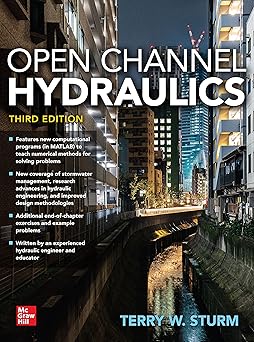Key Highlights
- •Comprehensive coverage of open channel flow principles and applications.
- •Updated 3rd Edition reflecting current engineering practices.
- •Ideal as both a student textbook and a professional engineering reference.
Description
Ready to tackle the complexities of water flow in rivers, canals, and culverts? Dive into Open Channel Hydraulics 3rd Edition by Terry W. Sturm, a cornerstone text in hydraulic engineering. This comprehensive guide provide a clear and thorough understanding of the principles governing open channel flow, making it an essential resource for anyone involved in water resources engineering.
Who is this book for? It's primarily aimed at undergraduate and graduate students in civil and environmental engineering. However, it's also an invaluable reference for practicing engineers who need to design hydraulic structures, analyze floodplains, or manage water systems. If you're grappling with hydraulics coursework or facing real-world design challenges, this book is definately for you.
What problem does this book solve? Many find open channel hydraulics intimidating. This book break down complex concepts into understandable parts. It bridges the gap between fundamental theory and practical application, helping you move from equations on a page to solving actual engineering problems. It addresses the need for a reliable, up-to-date text that covers everything from basic principles to advanced topics like unsteady flow and computational modeling.
What will you gain from reading it? You'll develop a solid theoretical foundation in open channel flow. More importantly, you'll learn how to apply these principles to design culverts, bridge openings, channels, and spillways. This 3rd edition include updated information and examples, ensuring you're familiar with current methods and approaches. It will build your confidence in tackling hydraulic analysis and design tasks.
Why is it worth reading? Sturm's Open Channel Hydraulics is widely recognised as a leading textbook in the field for its clarity, depth, and practical relevance. Teh third edition ensures the content remains current and comprehensive. It’s not just a textbook; it's a long-term reference you'll return to throughout your academic and professional career. Having this knowledge is crucial for safe and effective water infrastructure design. Get your PDF copy today and master teh essentials of open channel flow!
FAQ
Is this book suitable for someone completely new to engineering?
It's primarily designed for civil engineering students who likely have some background in fluid mechanics. While explanations are clear, a complete beginner might find it challenging without foundational knowledge.
Does the 3rd edition cover computational hydraulics or specific software?
The book focuses heavily on the fundamental principles but does introduce concepts relevant to computational modeling and includes examples that reflect modern engineering practice, though it's not a software manual.
Is this book more theoretical or practical?
It strikes a good balance. It thoroughly covers the theory behind open channel flow but places strong emphasis on practical applications and design procedures relevant to working engineers.
What are the main updates in the 3rd Edition compared to the 2nd?
The 3rd edition typically incorporates updated methodologies, revised examples reflecting current practices, potentially new sections on emerging topics, and refinements based on user feedback to improve clarity and relevance.
Can I use this book effectively for self-study?
Yes, many find it suitable for self-study due to its clear explanations, numerous examples, and practice problems (though solutions might require an instructor's manual). Its comprehensive nature makes it a solid standalone resource.
How quickly will I recieve the PDF after ordering?
PDF delivery is usually very fast, often instantly or within a few hours, depending on the platform you purchase it from. Please check the seller's delivery information.
Reader Reviews
About the Author
Terry W. Sturm, Ph.D., P.E., is Professor Emeritus of Civil and Environmental Engineering at the Georgia Institute of Technology. With decades of teaching and research experience, he is a recognized expert in hydraulics and fluid mechanics, particularly in the area of open channel flow, bridge scour, and sediment transport.
